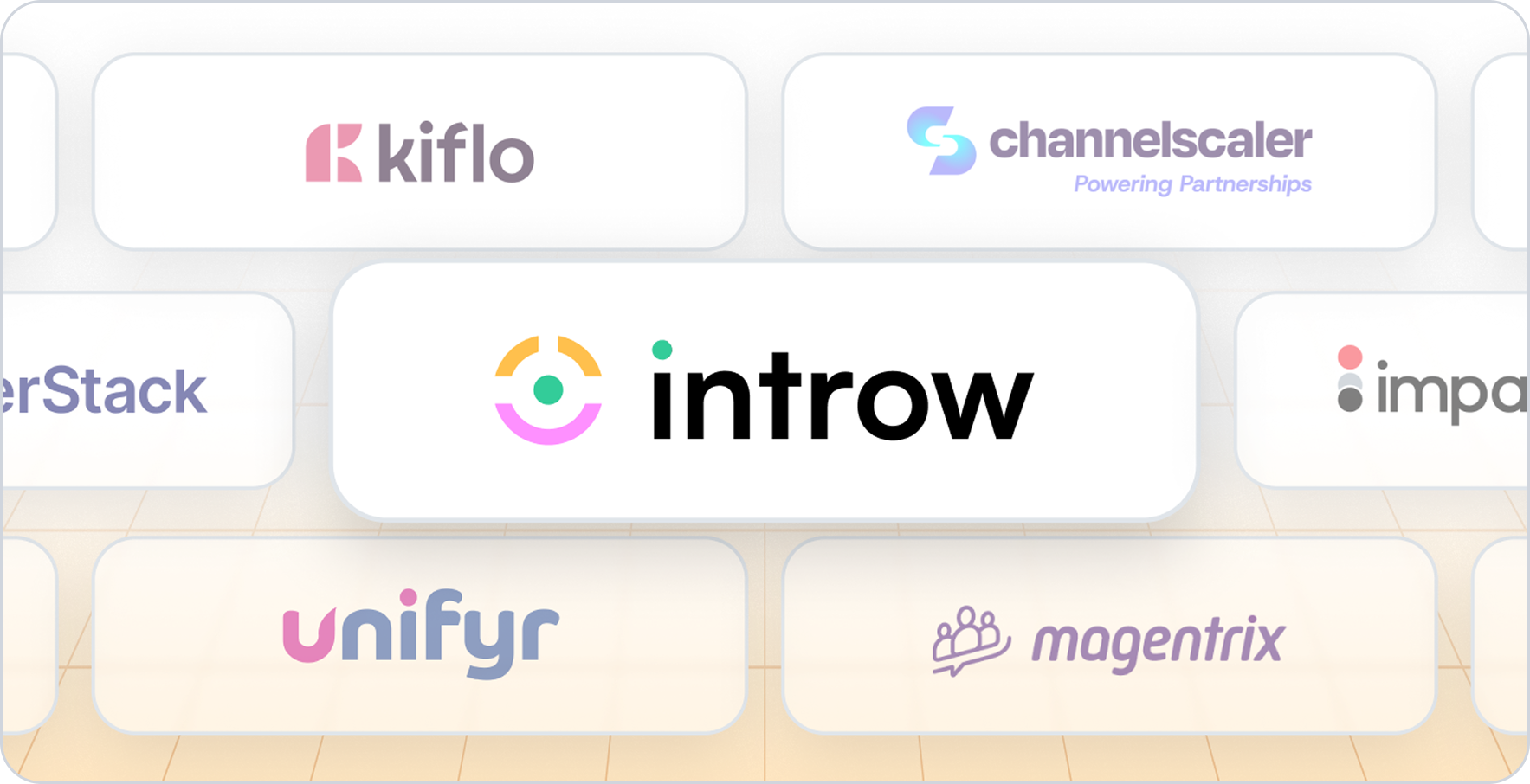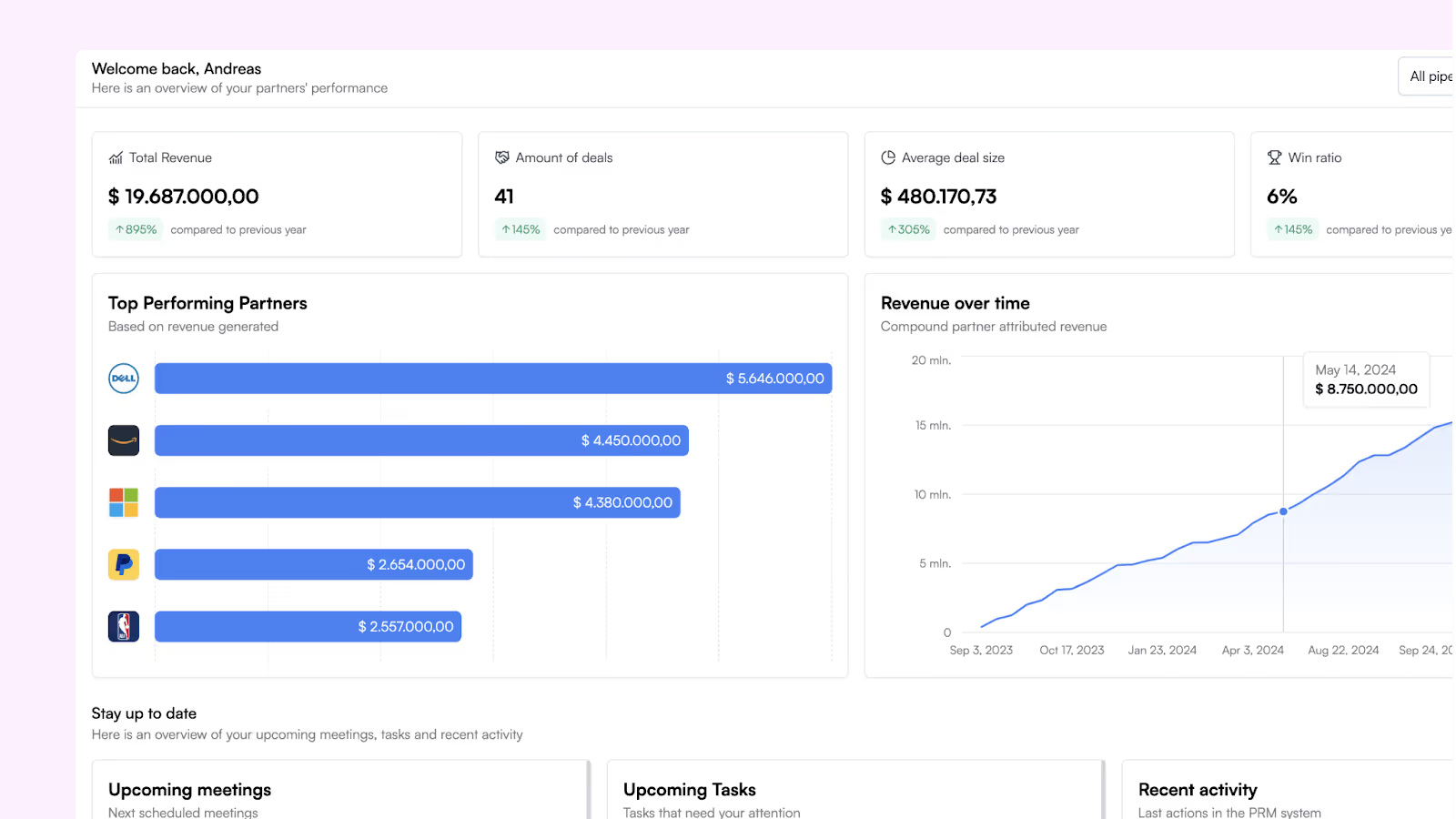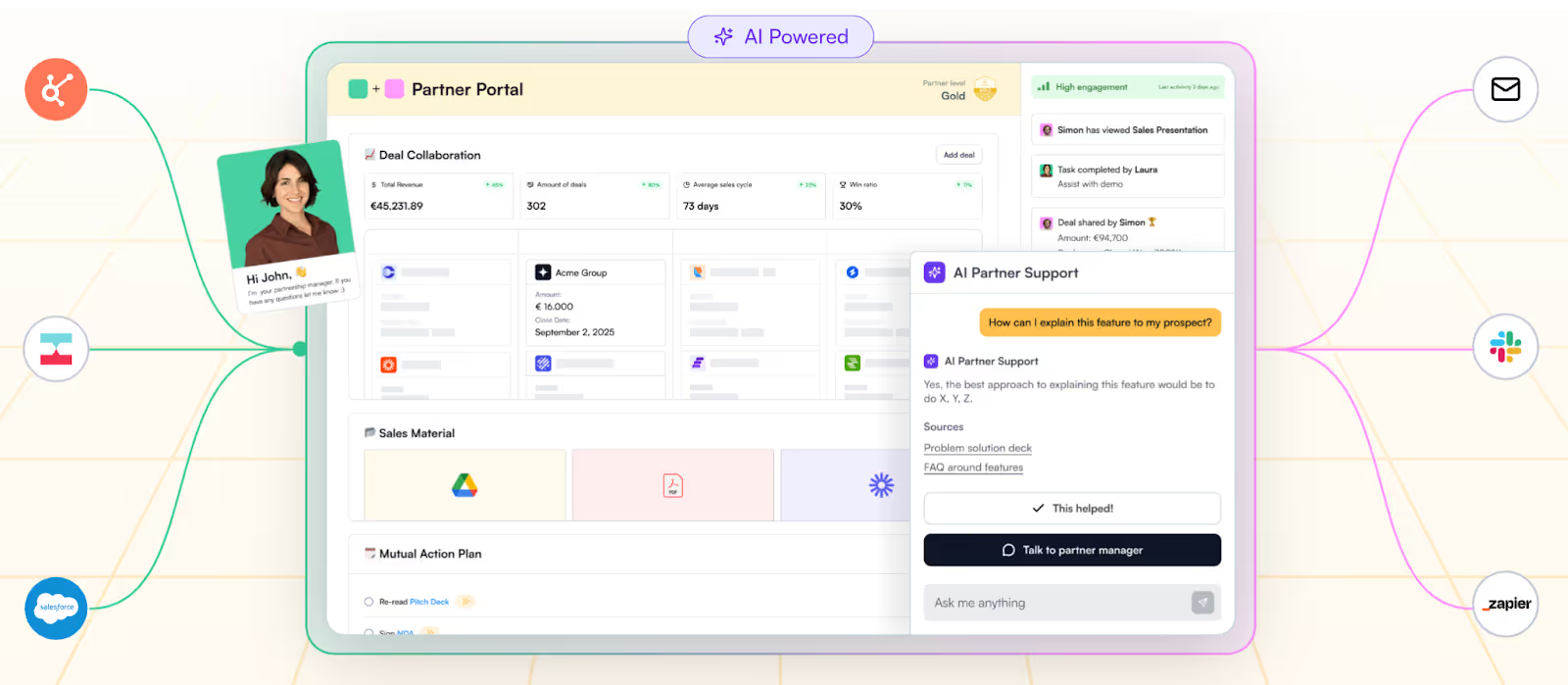Salesforce’s native PRM — now packaged as Partner Cloud on Experience Cloud — lets you build a partner portal, run deal registration, and connect partner activity into Sales Cloud and other Salesforce products. If your team is already all-in on Salesforce, it can be compelling. Still, many SaaS companies consider alternatives in 2026 for faster rollout, lower total cost, stronger HubSpot coexistence, or deeper support for motions like hyperscaler co-selling deals and affiliate marketing. The right partner relationship management software should automate sales processes, support opportunity management, and surface real time data for pipeline inspection across partners, customers, and channel sales.
Who this guide is for: B2B SaaS teams with active partner programs, at least two channel managers, and Salesforce or HubSpot CRM as the source of truth.
How we evaluated: CRM alignment (Salesforce and HubSpot), time-to-value, partner performance and adoption without logins, co-sell capability, affiliate needs across various industries, governance for RevOps, and reporting in the CRM. We also looked at AI capabilities, content management for enablement, and operational efficiency to drive long term success.
What to look for instead of Salesforce PRM
If you are replacing Experience Cloud for partners, prioritize CRM-first operations so sellers never leave Sales Cloud or HubSpot. Look for partner relationship management PRM workflows that reduce channel conflict, guide partners with in app guidance, and enable real time collaboration by email or Slack. You also want clean attribution and forecasting in the CRM, outcome based enablement that helps partners track progress and monitor performance, plus role-based access that keeps RevOps happy as you scale. Tools that automate sales processes, support custom objects, and give a complete view of customers, partners, and deals on a single platform will help many businesses improve market reach and reduce costs.
How to shortlist in 10 minutes
- Map motions — reseller, referral, co-sell, affiliate.
- Pick your CRM center — Salesforce only or Salesforce + HubSpot.
- Choose three to trial — e.g., Introw, Channeltivity, and Magentrix for CRM-first PRM; Impartner, ZINFI, Unifyr for enterprise channel scale; impact.com or Everflow for affiliate-heavy strategies; WorkSpan for hyperscaler co-sell.
- Score pilots on — time to first live deal registration, partner engagement without logins, CRM visibility, pipeline inspection, and forecast accuracy.
The 17 best Salesforce PRM alternatives in 2026
Whether you lean into referrals, resellers, co-sell, or affiliate, the options below span pure PRM software, co-sell orchestration, and performance-partner tools. For each, we highlight key features that affect partner productivity, customer data hygiene, and how easily channel managers can manage leads and opportunities across third party partners while staying fully integrated with your AI CRM and other Salesforce products like Service Cloud.
1) Introw
Best for: SaaS companies running referral, reseller, and co-sell motions that want the entire partner workflow to live in Salesforce or HubSpot — while keeping partners engaged through email and Slack so no one is forced to log in.
Why it’s an alternative: Instead of building a heavy Experience Cloud site, Introw keeps deal registration, collaboration, and reporting in your CRM and uses off-portal notifications so partners can reply to updates by email or collaborate via Slack — all synced back to Salesforce or HubSpot. That is a practical way to reduce portal fatigue, track deals and track leads with real time data, and speed time-to-value.
Callouts: Native integrations for Slack, HubSpot, and Salesforce help you capture leads and opportunities quickly. Partners can submit leads via public forms, email, or Slack, and every submission maps to the right CRM fields for clean attribution. If you are scaling a mixed motion — reseller, referral, MSP — the no-code partner portal, content management for enablement, and analytics make it easy to personalize experiences by partner type and monitor performance.
2) Impartner
Best for: Enterprises with global channels that rely on structured tiering, incentives, and MDF — and need proven governance at scale.
Why it’s an alternative: If custom-building PRM on Experience Cloud is too slow or complex, Impartner delivers mature modules out of the box — recruitment, enablement, deal reg, and MDF — with a track record in large channel programs.
Callouts: Its MDF tooling stands out — budgeting, approvals, reimbursements, and notifications are built into the PRM, which is valuable if partner funding drives growth. Third-party directories and analyst sites also show broad deployments and comparisons, plus AI functionality appearing across enablement and analytics.
3) ZINFI (Unified Partner Management)
Best for: Teams seeking a comprehensive PRM suite with strong analyst and peer recognition, plus a steady cadence of product updates.
Why it’s an alternative: ZINFI’s Unified Partner Management spans recruit, enable, market, sell, and incentivize. In 2026 the company continues to emphasize AI-assisted workflows — useful if you want breadth without assembling point tools.
Callouts: The company highlights ease of use and modularity across UPM. If you have multiple partner types and need one platform to cover lifecycle workflows end to end, this is a credible shortlist option for partner enablement and opportunity management.
4) Unifyr (formerly Zift Solutions)
Best for: Channel-heavy orgs that prefer one vendor for PRM, through-channel marketing, and training — rather than stitching together separate systems.
Why it’s an alternative: Zift Solutions rebranded as Unifyr and now positions an AI-enabled partner ecosystem platform. If your Experience Cloud setup became a patchwork of apps, Unifyr’s all-in-one packaging can simplify operations.
Callouts: Messaging focuses on onboarding, activation, and performance insights across the partner lifecycle — helping guide partners, track progress, and align sales processes with marketing.
5) Channelscaler (Allbound + Channel Mechanics)
Best for: Companies that want modern PRM UX combined with enterprise-grade pricing, rebates, and incentive automation — all in one platform.
Why it’s an alternative: Allbound and Channel Mechanics merged and rebranded as Channelscaler. For teams that would otherwise combine a PRM front end with a separate channel automation engine, this unified approach is attractive.
Callouts: Press and analyst notes highlight scalability and intelligence post-merger, with emphasis on accelerating indirect revenue, expanding market reach, and improving operational efficiency.
6) Channeltivity
Best for: Mid-market teams looking for fast time-to-value and clicks-not-code integrations with Sales Cloud or HubSpot.
Why it’s an alternative: Channeltivity’s plug-and-play CRM integrations minimize implementation risk versus custom sites. Deal reg and referrals sync into the CRM so sales and RevOps get partner pipeline inspection and visibility without manual work.
Callouts: The HubSpot marketplace listing and help center show two-way sync, field mapping, and setup guides — handy if you want to go live quickly without heavy IT, and still monitor performance and track deals.
7) Magentrix
Best for: Salesforce-centric programs that want a configurable partner portal tightly coupled to CRM objects and data.
Why it’s an alternative: Magentrix is a long-standing AppExchange PRM. Its approach centers on mirroring CRM structure and reducing brittle syncs, which can be smoother than building and maintaining a bespoke Experience Cloud site.
Callouts: Features include deal registration and assignment with automated notifications. The company also publishes guidance on CRM-to-PRM data mirroring — useful for teams managing customer data at scale.
8) PartnerStack
Best for: SaaS teams combining affiliate, referral, and reseller motions — and wanting marketplace reach plus automated payouts.
Why it’s an alternative: PartnerStack pairs PRM-like workflows with a robust rewards engine and partner marketplace. If paying many partners on time is your bottleneck, this can be more turnkey than building equivalents on Salesforce.
Callouts: Flexible commission triggers and scheduled payouts help finance and ops keep partners confident, especially when scaling long-tail programs across partners and customers.
9) Kiflo
Best for: SMBs and scale-ups formalizing their first partner program with a straightforward CRM sync.
Why it’s an alternative: Kiflo focuses on PRM basics — referrals, resellers, simple enablement — and integrates natively with HubSpot to sync leads, deals, and contacts. If Experience Cloud feels over-powered for your stage, this is a pragmatic start.
Callouts: Marketplace listings and docs show two-way sync and mapping, which reduces swivel-chair work for partner managers and RevOps.
10) WorkSpan
Best for: ISVs pursuing hyperscaler co-sell with AWS, Microsoft, or Google — and running marketplace private offers — who want those processes embedded in Salesforce.
Why it’s an alternative: WorkSpan is purpose-built for co-sell and marketplace operations and ships a Salesforce app to automate referral sharing with AWS ACE and Microsoft Partner Center. If your gap with Salesforce PRM is hyperscaler motion, this is a strong fit.
Callouts: The Hyperscaler Edition supports marketplace listings and private offer workflows and integrates with Salesforce, HubSpot, and Dynamics so alliance teams and AEs can operate from the CRM with real time data.
11) impact.com
Best for: Affiliate, influencer, and advocacy programs where discovery, contracting, tracking, and payouts need to live together.
Why it’s an alternative: Rather than bolt affiliate tools onto a PRM, impact.com centralizes the performance side of partnerships and automates contracts and payments. Many B2B brands pair it with CRM reporting to measure influenced revenue.
Callouts: Reviews and third-party roundups repeatedly highlight automation, fraud controls, and reporting — useful if partner marketing is your growth lever.
12) Everflow
Best for: Advanced partner and affiliate programs that need granular tracking, analytics, and a white-label experience for agencies or multi-brand portfolios.
Why it’s an alternative: Everflow emphasizes measurement — cross-channel tracking, detailed attribution, and integrations — so you can quantify pipeline and revenue without stitching multiple tools.
Callouts: Independent reviews point to robust analytics, clickless tracking, and marketplace options that help teams scale efficiently and track leads from various industries.
13) TUNE
Best for: Marketers who need a highly customizable partner marketing platform — flexible commissioning, deep tracking, and brandable partner experiences.
Why it’s an alternative: TUNE is known for configurability. If your commissioning logic or partner types do not fit a standard mold, TUNE’s platform can be easier than forcing that complexity into a generic affiliate add-on or a DIY Experience Cloud build.
Callouts: The product’s positioning around flexibility across mobile and web, plus pricing options, makes it an option when you want control more than templates.
14) Partnerize
Best for: Global brands scaling affiliate and partnership channels with AI-assisted optimization.
Why it’s an alternative: Partnerize has invested in AI functionality and data intelligence — helpful for predictive insights in partner recruitment and optimization. If your Salesforce PRM alternative needs performance marketing depth, shortlist this.
Callouts: Public posts underscore ambitions for category growth and an AI-powered roadmap, pointing to continued velocity.
15) PartnerPortal.io
Best for: HubSpot-centric channel managers who want a portal to capture leads and deals, share resources, and push updates — without heavyweight implementation.
Why it’s an alternative: Rather than rolling your own Experience Cloud site, PartnerPortal.io is plug-and-play for HubSpot. Partner-submitted leads can create or link deals, and the product ships a simple resource center and accounting integrations. There is even native Crossbeam support for attribution and account mapping.
Callouts: The marketplace pages show quick deployment, two-way sync, and a focus on keeping everything inside HubSpot — handy for teams trying to avoid net-new systems.
16) Partnero
Best for: Lean partner teams that need low-friction lead submission and simple affiliate or referral flows rather than a full PRM suite.
Why it’s an alternative: Partnero makes it easy to accept partner or public lead submissions through a customizable page and manage the accept or reject workflow — a lightweight way to operationalize referrals without a big build.
Callouts: Product updates highlight continued investment in lead submission, attribution, and payouts — useful when simplicity and speed matter most.
17) RocketPRM (Impulse Creative)
Best for: Organizations that are all-in on HubSpot and want a turnkey PRM built entirely on HubSpot CRM and CMS — no separate platform to administer.
Why it’s an alternative: RocketPRM lives inside HubSpot, so you can keep your existing deal pipeline and manage a partner-facing portal with HubSpot page layouts and forms. If your team wants to avoid juggling another vendor while staying native to HubSpot, this is a clean option.
Callouts: The vendor site and community posts explain the architecture and implementation, emphasizing a HubSpot-only approach that keeps partner data and workflows in one place.
When to stay with Salesforce PRM
Stick with Salesforce Partner Cloud when your GTM is truly Salesforce-only, you want to keep data and AI CRM investments under one roof, and your team can support an Experience Cloud build. Salesforce provides native deal registration, lead distribution, and partner portals within that ecosystem — which can be the most straightforward path if you are standardized on Sales Cloud, Service Cloud, and related platform services that collaborate with other Salesforce products on a single platform.
Switch when you need HubSpot coexistence, faster rollout, off-portal engagement, or hyperscaler co-sell. Those needs are precisely where the alternatives above usually win on time-to-value, partner productivity, and adoption.
Why Introw is your choice in 2026
If your team wants partner relationship management that is fully integrated with your CRM, Introw’s CRM-first approach keeps partners, AEs, and RevOps in one workflow. You can create and manage leads and opportunities, use custom objects where needed, and rely on real time data for tracking deals, attribution, and forecasting.
Off-portal email and Slack let third party partners collaborate without friction; outcome based enablement and a lightweight content management layer help guide partners, share resources, and monitor performance. The result is higher partner productivity, fewer sync issues when managing customer data, and measurable revenue impact across sales, marketing, and service teams — without the overhead of a custom Experience Cloud build. For many businesses, this combination of automation, AI capabilities, and operational efficiency translates to lower total cost and long term success. Book a demo to see for yourself.
Is “Salesforce PRM” the same as “Partner Cloud” and “Experience Cloud for Partners”?
Salesforce has consolidated PRM under Partner Cloud, which runs on Experience Cloud and connects to Sales Cloud. Help docs and product pages use these terms together — the essence is a Salesforce-native partner portal with lead distribution and deal registration that integrates with other Salesforce products and Service Cloud for service tools.
What’s the best Salesforce PRM alternative for HubSpot-centric teams?
Consider Introw for a CRM-first, off-portal approach; PartnerPortal.io for a 15-minute HubSpot portal; and RocketPRM if you want PRM built entirely on HubSpot objects and CMS. Each keeps customer and partner records aligned so you can track leads, track deals, and monitor performance from one place.
How does Introw boost partner productivity compared to classic Salesforce PRM builds?
Introw runs inside your CRM with in app guidance, Slack and email updates, and real time collaboration that does not require portal logins. That makes it easier to guide partners, reduce back-and-forth on sales processes, and collaborate on shared pipeline — improving partner performance while keeping data clean for pipeline inspection and forecasting.
Does Introw support both Salesforce and HubSpot with custom objects and real time data?
Yes. Introw is designed to sync custom objects, opportunity management, and attribution to your CRM so channel managers can manage partners on a single platform. The AI CRM context, AI capabilities, and automation ensure real time data for reporting and reviews across business functions.


.svg)

























